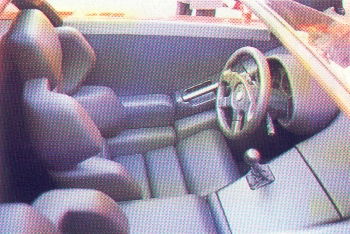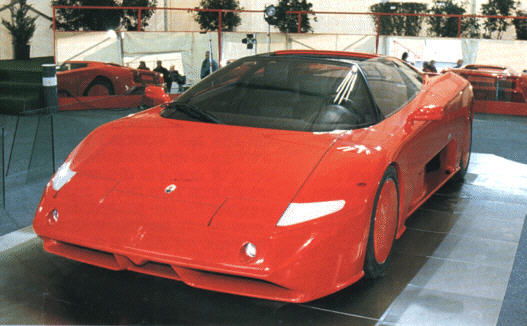1990 Maserati Chubasco Prototipo


"A wind that blows in the Gulf of California."
On 14 December 1990, Maserati presented one of the most innovative prototypes of its history: the Chubasco. Unveiled to the press, customers and dealers during the annual Maserati festivities in Modena, the Maserati Chubasco shared the stage with two new models: the Maserati Shamal and the Maserati Racing. The Chubasco was built to be the car of every enthusiast’s dreams and was shaped by a pure passion for fast cars using the most sophisticated technologies the early Nineties had to offer.


The star of that event was a completely new car that was both formally and mechanically detached from Maserati’s range at the time. A car that would stir the memories - and what memories! - of the the powerful two-seater sports cars of the past.

From the first discussions Marcello Gandini had with the Maserati design office, it was clear that the car to be created would be new and revolutionary in every respect.
The point of departure: the mechanicals.
The primary constraint on body configuration was the requirement for good air circulation in those points of the car in need of cooling: radiators, air-conditioning condenser, heat-exchangers, turbo-chargers, electronic control units, catalytic converters, engine compartment in general, mufflers and brakes.
To achieve the desired end result in terms of performance, the best available frame proved to be the central-beam type, which provides good rigidity in combination with a supporting engine-transmission group mounted in a centre-rear position. This concept originated with De Tomaso’s positive experience with the Vallelunga.

The chassis was to be a central beam in combination with a supporting engine-transmission group.
The chassis would provide anchor points for the front push-rod and rear pull-rod suspensions, with a hydraulic lifting and progressive rigidity system and rockers with inboard springs, a solution typical of F1, which leaves room for two large lateral ducts for air passage and distribution.

The push-rod front suspension and the pull-rod rear suspension.
In plan view, these ducts are shaped so that the airflow taken in by three large frontal airscoops is accelerated and exhausted laterally under the doors, providing a pressure drop beneath the side panels, thus enhancing the strong ground-effect produced by the rear ramp and flat under-tray.

The air flow taken in by the three frontal air scoops is accelerated and exhausted laterally under the doors. Cooling air for the engine is taken by two other air scoops in front of the rear wheels and is exhausted at the rear.
The monocoque or carbody is ideally conceived as a floating cell connected to the frame by means of damping supports that absorb vibrations from the engine, transmission, suspensions and wheels, insulating the cockpit from whole frequency range of noise and vibrations and from torsion.

The car body is conceived as a floating cell all connected to the chassis by means of dampening supports.
The doors are single-hinged in front and open upward and forward.
The electrically-controlled roof section could be shifted rearwards above the engine compartment, thus allowing oper-air motoring.
The carefully-designed side and rear window surfaces and the driver’s seat offer better visibility than in most mid-engine sports cars.
The “mandatory” two-seat cockpit is unexpectedly roomy, both lengthwise and laterally. The anatomical seats are separated by a centre-beam tunnel, which acts as a practical element of support and esthetic balance. A large spoiler, aerodynamically tuned in the wind tunnel, characterizes the car’s appearance from all angles of observation.

The car that resulted from these ideal concepts is as difficult to describe in normal terms as the dreams of sports-car lovers.
“It’s a coupé but also an aggressive roadster.”
“It’s a F1 with air-conditioning.”
“It’s a bomb with superlative performance.”
Precisely for this reason Maserati, for the first time in its history, presented a static model rather than a prototype. A model, not a useless knick-knack but a working instrument indispensable to the birth of an automobile.
With this objective, Maserati wished to involve everyone in this project, perhaps because an extraordinary automobile should in reality be designed by its potential owners.
Sadly this was not to be the case as it proved to be too expensive to build and the Chubasco remains in its mock-up form to this day and is now housed in the Panini Museum on the outskirts of Modena.
The good news is that Maserati used this technology to build the Barchetta.

The Chubasco - Technical Data and Dimensions.
Engine: Rear engined twin-turbo V 8-cyl @ 90º
Cubic capacity: 3217 cc
Distribution: Four overhead camshafts with 4 valves per cylinder
Power output: 430bhp @ 6500 rpm
Lubrication: Dry sump
Gearbox and clutch: 6-speed and reverse - dry twin-plate plate
Transmission: Rear wheel drive
Wheelbase: 2310mm
Wheel track: Front - 1640mm / Rear - 1660mm
Bodywork: Two-seater
Overall dimensions: Length - 4365 mm / Width - 2014 mm / Height - 1124 mm
Follow me on Facebook, Instagram, YouTube or Snapchat at alexandrei64
The original article was so good I only had to change so little to it, check it out here
Tagline: #blogpost #italianheritage #CTarticle
Comments
Its incredible-ly 90’s
Awesome article, very detailed, thanks for sharing
This looks eerily like the Bugatti EB110.
Maserati chewbacca?
Chubasco means drizzle in spanish and italian
The rear wheel arch looks a lot like the wheel arch of the Countach
Looks cool
Very similar to the Diablo. Leaving that aside, I really like the design of it, except the rear wheel arch, I find it weird, I know “it’s a 90’s thing” but still
It looks great.
Dat ass!
Pagination